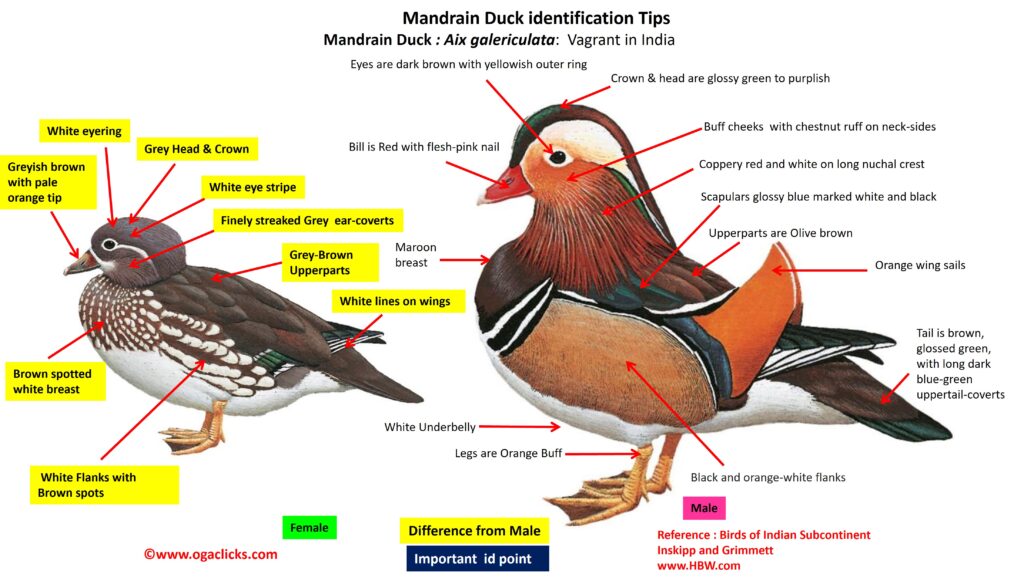
Mandrain Duck Aix galericulata
Etymology:
- Aix : Greek word for diving bird
- Galericulata : Latin word galerum – cap
Distribution in India: Vagrant in North East India
Description: Size of 41–51 cm; wt. of male 571–693 g, female 428–608 g; wingspan 68–74 cm. Male has eclipse plumage, but in breeding plumage has orange wing sails and side whiskers. The forehead and crown are glossy green to purplish, becoming coppery red and white on long nuchal crest, buff cheeks with chestnut ruff on neck-sides and foreneck. The mantle and back are olive-brown, scapulars are glossy blue marked white and black, tertials are blue, with orange-buff outer webs, upper breast is maroon, lower breast to undertail-coverts are white, with black and orange-white bars on flanks. The tail is brown, glossed green, with long dark blue-green uppertail-coverts. The bill is red with flesh-pink nail, legs and feet are orange-buff and eyes are dark brown with yellowish outer ring. The female (and eclipse male) resemble same plumages with white ring around eye typically extends as line behind it, have different bill pattern (greyish brown with pale orange tip), pale grey head with finely streaked ear-coverts, more heavily spotted underparts, striking white lines on inner secondaries, less clear-cut white throat and paler legs. The juvenile resembles female, though female has pinkish bill, and young are more uniformly grey-brown with less distinct face markings and less obviously dappled appearance to upper breast and flanks.
Habitat: It is found in pools, lakes, rivers, marshes and swamps surrounded by dense deciduous forest. It has a preference for small islands and waterbodies with abundant emergent vegetation and wooded islets. It is found below 1500 m.
Food habits: It eats seeds, nuts, acorns, sweet chestnut, beechmast and grain, aquatic plants and animal food like land snails, frogs, tadpoles, insects, fish. The Invertebrates are important in diet of ducklings. Regularly feeds in flooded rice fields after harvest. It feeds both by day (most active early morning and evening) and at night by dabbling on water surface and shoreline, and by head dipping and upending in shallow waters. It rarely dives.
Breeding habits: They breed in Apr in England and Russia, Jun in Japan. They are Monogamous but not territorial with pair-bond lasting until late in incubation period. It nests mainly in tree hollows, selected by both pair-members, including old woodpecker holes . They lay a clutch of 7–14 eggs, laid at one-day intervals. The incubation period is 28–33 days by female alone. The fledging period is 40–45 days, with young cared for entirely by female.